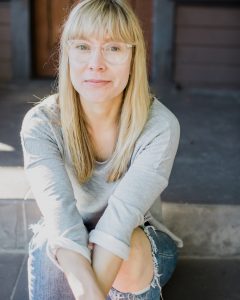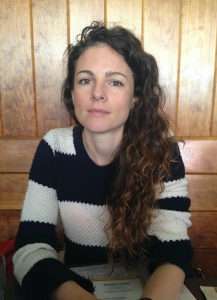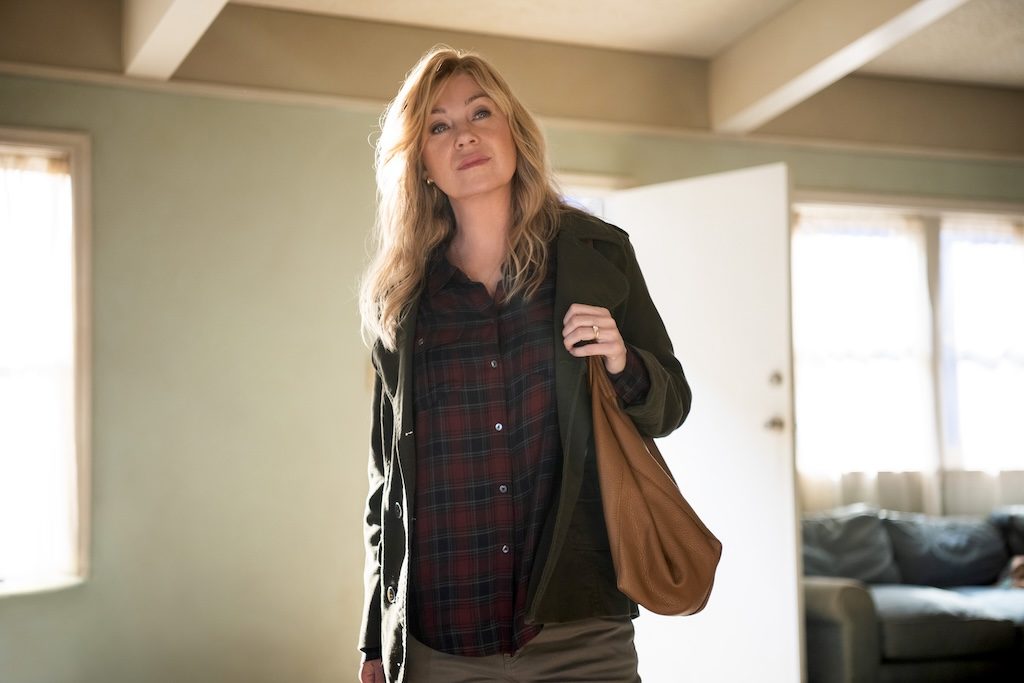“Depending on whose account of the story you were reading, depending on who was being interviewed, it really changed the way I understood the story,” recalls co-showrunner Katie Robbins who created and executive produced Hulu’s Good American Family with Sarah Sutherland. This compelling drama is inspired by the disturbing stories surrounding a Midwestern couple who adopts a girl with a rare form of dwarfism who is actually an adult.
“I read an interview with one of them and said, ‘Oh my gosh, this is exactly what happened.’ And then I’d go and read another interview with a different person involved in the story and say, ‘Oh no, I was completely wrong.'” Robbins is describing her experience adapting the controversial true story of the Barnett family and their adopted daughter Natalia Grace.
The new series, starring Mark Duplass as Michael Barnett, Ellen Pompeo as Kristine Barnett, and newcomer Imogen Faith Reid as Natalia, chronicles the complex and contested narrative between a couple who claimed their adoptive daughter was actually an adult con artist posing as a child.

Katie Robbins
The creative partnership between Robbins and Sutherland stretches back to their time on Showtime’s The Affair, where Sutherland served as script coordinator and later staff writer while Robbins joined the writing staff in season four. “Sarah’s brain was one that I just had a crush on from the beginning,” Robbins explains.
“She just had this way of thinking about things that was similar to mine, but different. And I just loved talking to her about stuff. She’s a real philosopher, and also a total nerd and weirdo. So the combination of all of those things was just really delicious.”
The Rorschach Test
The inspiration for Good American Family came in 2020 when Hulu approached Robbins about developing the Barnett-Grace story into a series. “It wasn’t kind of as much in the popular consciousness as it is now,” Robbins notes. “I did a lot of research and read a bunch of articles and watched interviews with them. And I was really struck by the fact that depending on whose account of the story you were reading, it really changed the way I understood the story.”
This ambiguity fascinated Robbins. “The story took on this kind of like Rorschach test feeling where, depending on your experiences and depending on who was telling it, it completely changed the way that you interpreted it.”
Structurally, Robbins made a bold choice: some episodes are told from the perspective of the adoptive parents, Christine and Michael Barnett, while others shift to Natalia’s perspective, fundamentally challenging the audience’s understanding of events.
[Melanie Marnich On ‘The Affair’]
“It became a series about narrative perspective, point of view and the elusive nature of truth,” Robbins explains (not unlike parts of The Affair). “Depending on how well a person tells a story, you believe it no matter what the actual facts of the matter are.”
When it came time to bring on a co-showrunner, Robbins immediately thought of Sutherland, though convincing her wasn’t easy. “It took some convincing,” Robbins admits. “I really had to play my cards right.” Sutherland’s hesitancy stemmed from the story’s emotional weight. “It’s a really sad story,” she explains. “It hit on certain themes that were sad for me for personal reasons. I said, ‘I’m fascinated by it. I know it’ll be a great show. I don’t know that it would be good for my mental health, but go with God.'”
What ultimately won Sutherland over was Robbins’ script and her unique approach to the material. “Once I read the script, I felt like, ‘Oh, okay. Of course, Katie’s figured out a way to humanize and make this feel like a story that should be told.'”
Deep in the Research
“When we were really deep in the research, we knew stuff that’s not public. We had a person on the ground in Indiana who was feeding us information from the trial as it was going on,” Sutherland reveals. “When you sit with the research, most people would write it in a way that just demonized some of the characters. Katie from the beginning takes this position that to actually have empathy for these people, even the people who are doing things that are really pretty horrifying, is actually a much more meaningful way to explore what it is to be human.”

Sarah Sutherland
The show’s structure deliberately guides viewers through different emotional experiences.
“In episodes one through four of our series, which are episodes told from the perspective of Christine and Michael, we’re never in a scene alone with Natalia,” explains Robbins. “You never really get to see things the way that she is seeing things. You never get to feel her as a POV character until finally you get to her perspective.”
This intentional storytelling choice creates a profound shift when the perspective changes. “Suddenly being in a room alone with Natalia when we finally get there will feel very different. All of a sudden, the things that you understood to be true don’t feel necessarily like they are true because suddenly you’re aware that you’ve been missing this entire piece of the puzzle.”
“We also made adjustments with our incredible directors and directors of photography to the way that the show looks and feels from perspective to perspective. It starts in this slightly heightened, occasionally campy kind of tone as Christine and Michael are trying to put their version of events into the ether. And then that shifts and it starts to become more grounded and a little bit grittier as we get into Natalia’s perspective.”
Sutherland notes that this approach allows the series to reach something closer to truth by the finale. “Episodes five and six are from Natalia’s perspective and then seven and eight go back and forth between the two. What’s true about these stories is that we tell on ourselves. Even when you’re in the Barnetts’ perspective, there are elements that are not pro-Barnett. And when you’re in Natalia’s perspective, there are things that are not pro-Natalia.”
“By the end, especially when we’re going back and forth between the two, it starts to become clear that there’s corroboration for some things that are said and not, and a really interesting lack of corroboration for other things.”
Finding Natalia
Perhaps the most crucial element in bringing this story to screen was finding an actress who could embody the complexity of Natalia Grace – someone who needed to believably appear as both a child and potentially an adult. “Hulu made the series pickup contingent on finding somebody to play Natalia,” Robbins reveals. “We did an international casting search with our incredible casting directors.”
Among countless submissions was a self-tape from Imogen Faith Reid. “The second we saw this, it was like the stories you hear of Hollywood – like Louis B. Mayer wandering into the Schwab’s drug store and saying, ‘You’re going to be a star.’ It was like that. You were just like, ‘Oh my God, this girl is incredible.'” Reid, who had minimal professional acting experience, faced tremendous challenges in the role.

Kristine Bennett (Ellen Pompeo) Photo by Disney/ Anne Marie Fox
“She had to play a character who goes just in literal years from seven to nineteen,” Robbins explains. “But she also had to play different versions of herself where from the Barnetts’ eyes, she seems to be like an adult, murderous con artist, and then like a child who has been abandoned.”
The showrunners were committed to authentic casting, noting that Reid has dwarfism, though a different form than Natalia’s. “So trying to figure out how to portray Natalia without mimicking the co-morbidities that go along with Natalia’s dwarfism – she worked with a movement coach on that. And she also, because she’s British, had to work with a dialect coach to achieve an American accent.”
“It was among the biggest acting feats I’ve ever seen accomplished on the shoulders of somebody who did not have a ton of experience,” Robbins says admiringly.
Advice for Aspiring Writers
When asked for advice for writers trying to break in today, both showrunners emphasized the importance of observation and research. “Read a lot, watch a lot. And watch not just what’s happening on television or in movie theaters, but watch the world around you,” Robbins advises. “At the end of the day, what we’re doing as writers is trying to make meaning of life. So being a good student of life is really the biggest thing.”
“I’m obsessed with research. People are fascinating. The world is fascinating. And even if the thing you’re writing doesn’t seem like it requires research, do some research anyway, because you’ll probably find more interesting tidbits in the stuff that you read than you could ever possibly imagine on your own.”
Sutherland shares advice she received early in her career from writer Carly Mensch, “Write the conversations you want to be having with society at large. Think visually, not just about words on a page. Think about the audience, entertain them, respect them, challenge them.” She adds her own suggestion: “Find mentors and writers who you admire and try to work with them, because having people whose taste you like and whose way of moving through the world you like helps so much.”
This interview has been condensed. Listen to the full audio version here.

